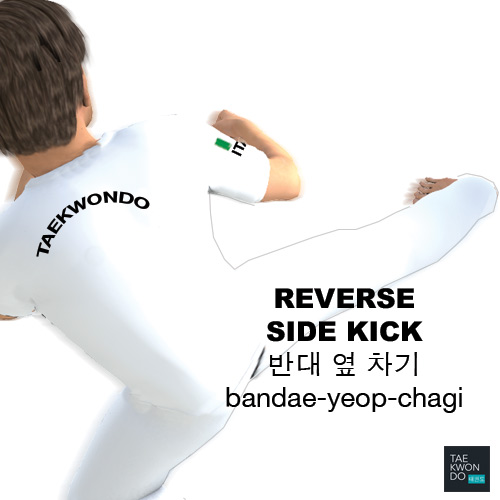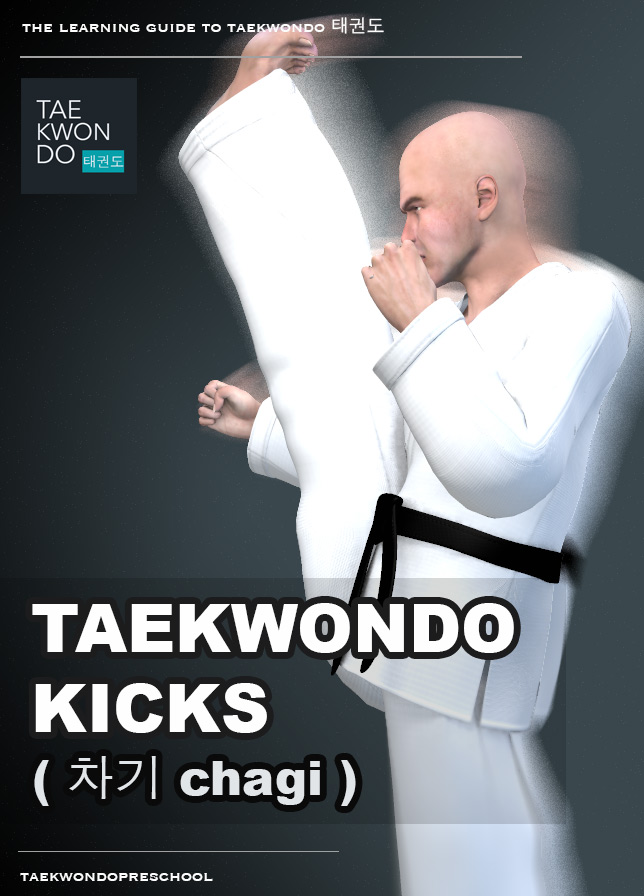Taekwondo 태권도Taekwondo Preschool
Promotion from one geup to the next can proceed rapidly in some schools, since schools often allow geup promotions every two, three, or four months. Students of geup rank learn the most basic techniques first, and then move on to more advanced techniques as they approach first dan. Many of the older and more traditional schools often take longer to allow students to test for higher ranks than newer, more contemporary schools, as they may not have the required testing intervals. View Taekwondo belt levels »

Reverse Side Kick
반대 옆 차기 bandae-yeop-chagi
A kick (차기 chagi) is a physical strike using the foot, leg, or knee. The striker relaxes to the extent possible during the strike, tensing the muscles of much of the body only at the time of impact, then relaxing again to recoil the striking part. Relaxation enables the strike to achieve the greatest possible velocity during travel, while rigidity at impact allows the maximum transfer of force.
Difficulty Level: Intermediate Technique: Kick ( 차기 chagi )
In Korean martial arts taekwondo, the Reverse Side Kick ( 반대 옆 차기 bandae-yeop-chagi ) is similar to the Back Kick ( 뒤차기 dwi-chagi ) by turning the body away from the target. Here the body turns further, allowing the foot blade ( 발날 balnal ) to hit the target with the foot ( 발 bal ) pointing to the side as in a regular Side Kick ( 옆차기 yeop-chagi ), instead of more downward out thrust as in a true Back Kick ( 뒤차기 dwi-chagi ).
Remember to look over your shoulder ( 어깨 eokkae ) and kick ( 차기 chagi ) in a straight line when delivering the Reverse Side Kick ( 반대 옆 차기 bandae-yeop-chagi ) to accurately target where you're kicking and to maintain a firm balance.
The kick ( 차기 chagi ) is versatile and is performed in sparring ( 겨루기 gyeorugi ), breaking ( 격파 gyeokpa ), self-defense ( 호신술 hosinsool ), one-step sparring, and demonstrations. The Back Kick ( 뒤차기 dwi-chagi ) is a technique that a practitioner should practice often and master. Practice is the act of rehearsing a behavior over and over, or engaging in an activity again and again, for the purpose of improving or mastering it, as in the phrase 'practice makes perfect'.
Variations of Back Kick ( 뒤차기 dwi-chagi )
- Back Kick ( 뒤차기 dwi-chagi )
- Reverse Side Kick ( 반대 옆 차기 bandae-yeop-chagi )
- Jumping Back Thrust Kick ( 뛰어 뒤차기 ttwieo-dwi-chagi )
Training Methods
How well one improves with training depends on several factors, such as the frequency it is engaged in, and the type of feedback that is available for improvement. If a student does not train often enough, reinforcement fades, and he or she is likely to forget what was learned.
During training, taekwondo practitioners may use various equipment and gear for practicing the kick ( 차기 chagi ). Taekwondo extensively uses the heavy bag for developing power and endurance. Powerful strikes to the heavy bag aren't recommended for inexperienced, or younger athletes, as risk of sprain, strain, or bone plate damage may adversely affect bone structures. It is highly recommended to carefully focus strikes to reduce chance of injury.
The kick ( 차기 chagi ) is best learned initially striking at the air as though there is an opponent but focusing on the form, speed, control, and technique; then moving on to soft surfaces striking punch mitts and target pads. Large heavy bags are used more for strength and endurance, while smaller targets such as punch mitts and target pads focus on faster kicking speed, timing and coordination. Target pads are useful for training mobility and accuracy on a moving target.
Also a chest protector ( 호구 hogu ) worn by a partner can be used as a stationary or moving target which is useful for getting the feel of impacting the opponent. The chest protector ( 호구 hogu ) is the armor worn by practitioners of taekwondo during sparring ( 겨루기 gyeorugi ).
In preparation for full contact sparring, students may be required to wait a few months, for safety reasons, because they must first build the skills they would ideally employ in their sparring practice. Some schools restrict the amount of force that may be used to hit an opponent, by allowing 'light contact' during sparring. Light contact allows a student to hit an opponent getting the feel of impacting the opponent but with controlled force and not full power. Light contact sparring is a good method to practice the technique.
Difficulty of Technique
Taekwondo students of geup ranking learn the most basic techniques first, and then move on to more advanced and difficult techniques as they approach 1st Dan Black Belt. The more difficult the technique, the more practice may be needed for the purpose of improving or mastering it, as in the phrase 'practice makes perfect'. Every technique must display the requisite speed, balance, power and firmness to be realistically used as an attack or defense move.
* Please see a certified Master Instructor ( 사범님 sabeomnim ) for training. Proper guidance and instructions are needed to ensure safe training.
Promotion Tests
Students often undergo periodic testing and grading by their own Master Instructor ( 사범님 sabeomnim ) in order to advance to a higher level of recognized achievement such as a different belt color. They need to demonstrate their proficiency in the various aspects of the art such as the execution of patterns ( 품새 poomse ), which combine various techniques in specific sequences.
Reverse Side Kick ( 반대 옆 차기 bandae-yeop-chagi ) is a requirement for the below belt levels (Techniques vary between schools). Promotion from one belt level to the next can proceed rapidly in some schools, since schools often allow geup promotions every two, three, or four months. Students of geup rank learn the most basic techniques first, and then move on to more advanced techniques as they approach first dan black belt. View Promotion Tests »

Training Safety Precautions
Starting with coloured belts taekwondo students must learn Breaking ( 격파 gyeokpa ). As they progress through the ranks, the breaks they perform increase in difficulty as do the number of boards. Wooden boards are the most common breaking item in most martial arts.
There are safety concerns with taekwondo breaking ( 격파 gyeokpa ), so one should seek out a certified Master Instructor ( 사범님 sabeomnim ). There are many small bones of the foot ( 발 bal ) and hand ( 손 son ) which need to be very carefully and slowly conditioned for safety. Repeated damage to the extensor capsules of the knuckles can lead to long term problems with dexterity. View Breaking ( 격파 gyeokpa ) »
* Please see a certified Master Instructor ( 사범님 sabeomnim ) for training. Proper guidance and instructions are needed to ensure safe training.

Training Highlights Summary
The Kick ( 차기 chagi ) contains many key point highlights. There are some that are simple and straightforward but then some are complex and detailed that require repeated training to learn and master.
- similar to the Back Kick ( 뒤차기 dwi-chagi ) by turning the body away from the target
- remember to look over your shoulder and kick ( 차기 chagi ) in a straight line
- the body turns further, allowing the foot blade ( 발날 balnal ) to hit the target in side kick ( 옆차기 yeop-chagi ) form
- suitable targets for the Foot Blade ( 발날 balnal ) are the chin ( 턱 teog ), nose ( 코 ko ), throat ( 목구멍 mokgumeong ), and chest ( 가슴 gaseum )
- taking an extra step forward with Rear Foot Forward Step ( 뒷발 내딛기 dwitbal-nae-ditgi ) will increase the rotation momentum and ultimately the speed and power of the kick
Strength Requirement of the Technique
Most strikes should generally be thrown with some measure of shifting body weight supporting the blow. The striker in combat should attempt to strike through the target area, not just contact the surface. Some strikes do not need as much strength as they target vulnerable areas such as the eyes ( 눈 nun ), neck ( 목 mok ) or sternum ( 흉골 hyung-gol ). The below is an approximate measurement of how much strength the strike requires from the practitioner to be effective.
Precision of Kicking ( 차기 chagi ) Technique
With proper execution opponents may be stopped with a single striking blow, which lessens the number of further strikes. Some kicks ( 차기 chagi ) can strike with more precision which will often cripple or knockout the opponent. The below is an approximate measurement of how precise the kick ( 차기 chagi ) requires from the practitioner to be effective.
Experienced practitioners learn through repetition and muscle memory when (not just how) to launch particular kicks ( 차기 chagi ), based on the circumstances they are facing.
* Please see a certified Master Instructor ( 사범님 sabeomnim ) for training. Proper guidance and instructions are needed to ensure safe training.
Risk of injury can be reduced by completing an effective warm up consisting of a heart raiser to get your pulse up, followed by sport specific dynamic stretches (stretches whilst moving). Please follow the guidance of a certified Master Instructor or trainer when doing sports related activities. Depending on the intensity of the exercise, cooling down can involve a slow jog or walk, or with lower intensities, stretching can be used. Cooling down allows the heart rate to return to its resting rate. View more information on Warming Up and Cooling Down ».
This article uses material from the Wikipedia articles "Warming Up" and "Cooling Down", which is released under the Creative Commons Attribution-Share-Alike License 3.0.
RESOURCES
This article uses material from the Wikipedia article "Kick" which is released under the Creative Commons Attribution-Share-Alike License 3.0.













































